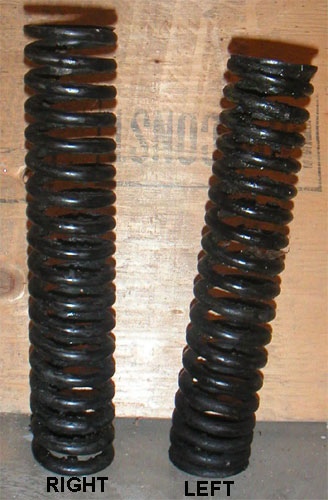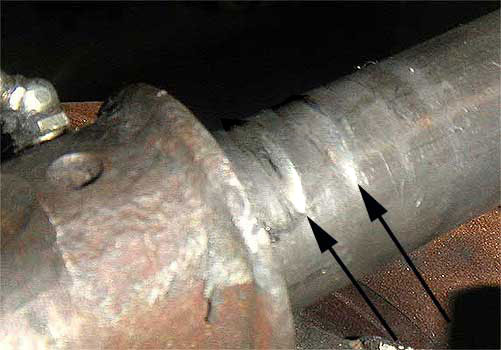This is our recommendation spring rate of choice for a road driven Plus 8, Plus 4 or Roadster. It was the standard for 50 years.
Currently (2015) 125 lb I have been told (though have NOT verified it) that all current Classics, excluding the new "Plus 8", the Aero with a tradesque body. A single Spring Rate makes sense now as the chassis was standardized for all classics at the end of 2004. The 4/4 is essentally now the same car as the others but with less power. It is no longer distinctive in its handling and feel as it was before 2004.
| SUPLEX NOTE: Suplex, one of the new aftermarketeers who has entered the Morgan market in the last few years, sell front springs measure in at 100 lbs. That explains the HUGE amount of preload. |
DETERMINING WHEN TO CHANGE COIL SPRINGS
by GoMoG
On Morgans, the Main Coil Springs are assembled within the kingpins, coiling around them.
Coil springs can and will become compromised after time. There is really no expiration date on coil springs. Age is likely the determining culprit, but binding springs can hasten a demise. Coil springs are much more durable than shocks. Many times replacing the shocks will return the vehicle back to its original level of performance., but there are a few things to check for when inspecting your suspension.
Firstly, jounce the front suspension (and the rear, for that matter) and count how many bounces occur after you release the vehicle. Two or more full bounces means weak shocks. I shoot for 1.5 bounces back and front. Less than that indicates at super hard or seized suspension. It is the shocks' job to dampen the vibration and prevent the bouncing.

 However,
the use of failed shocks will also take their toll on coil
springs if they are left ignored for a long period of time. As the
coils weaken, you will notice clunking or bottoming-out sounds, because
the coils are no longer capable of absorbing impacts or
providing stability and poise to your vehicle.
However,
the use of failed shocks will also take their toll on coil
springs if they are left ignored for a long period of time. As the
coils weaken, you will notice clunking or bottoming-out sounds, because
the coils are no longer capable of absorbing impacts or
providing stability and poise to your vehicle.In addition, weakened coils will, in turn, damage the shocks, because their rebound distance will be much farther than the components were intended to perform. Weak coils (and leaf springs at the rear) will compromise the ride height of the vehicle, and this symptom will affect the entire vehicle's alignment. Measuring the ride height of the vehicle and comparing that with the specifications will help you determine whether the coils are working in conjunction with the shocks.
Things to Look For
1. Some Morgan eras and models have a long history of snapping coil springs and rebounds. When inspecting coil springs, run your hands all the way around the coils, front sides and back.
2. Another thing to listen for creaking. Broken springs will often announced themselves. You can encourage this leading by turning the steering wheel back and forth and listening for binding or creaking noises. Compromised damper plates will also manipulate the coil springs in ways they will not be happy with. The rubbing can result in weird uneven wear of dig ugly grooves on the axle's kingpin tube. None of this is evidence of a happy front suspension handling and comportment.
What to Do and When to Do It
Should you replace coil springs each time you replace shocks? Absolutely not. Inspect the coils every time you replace any suspension component. Tie rod ends, stub axle greasing or when replacing kingpins and bushes.
| WATCHPOINT II The saddest thing about the cult of constant change at the factory is that, once they left their century-old template and datum, some design mistakes had to happen. Sadly, resources are limited in small company and the extensive testing common to the auto industry cannot be done at Morgan, if to the extent it was prior to 2000. So these changes often require more changes as correction and so on. The resultant credibility problem has left the newer Morgan community vulnerable to new aftermarket predators. This has also unfortunately affected sales ..especially with the newer models. Additionally these days, one is just as likely to be advised to completely and invasively overhaul one's Morgan suspension system at an enormous cost with after-the-fact kits as to simply do a but of needed maintenance or analysis. Of course, all suspensions deteriorate incrementally. The non-mechanical owner often doesn't notice until his is very bad and then they are told that the fault is the basic design that has been used for 100 years+! I am bemused that this argument can be persuasive. Even the factory has to wait until something breaks and they are informed, at which point they will eventually come up with a fix that can be purchased from them...and yet another change is born. DDE. |